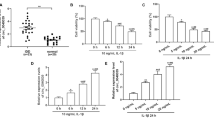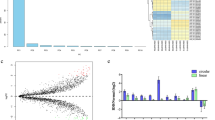Abstract
Inflammation and apoptosis are two important pathological causes of intervertebral disc degeneration (IDD). The crosstalk between these two biological processes during IDD pathogenesis remains elusive. Herein, we discovered that chronic inflammation induced apoptosis through a cullin–RING E3 ligase (CRL)-dependent mechanism. Two cullin proteins, CUL4A and 4B, recruited DNA damage-binding protein 1 (DDB1), RING-box protein 1 (RBX1) and DDB1- and CUL4-associated factor 6 (DCAF6) to assemble a CRL4DCAF6 E3 ligase in intervertebral discs (IVDs) derived from IDD patients. The CRL4DCAF6 E3 ligase ubiquitinated and degraded C-terminal-binding protein 1 and 2 (CtBP1/2), two homologues of transcriptional corepressors. The degradation of CtBP1/2 disassociated from the p300–forkhead box O3a (FOXO3a) complex, inducing the expression of B-cell lymphoma 2 (Bcl2)-binding component 3 (BBC3) and causing BBC3-dependent apoptosis. TSC01131, a small molecule that specifically targets CUL4–DDB1 interaction, could inhibit the ubiquitination of CtBP1/2 in vitro and in vivo, thereby decreasing the BBC3 expression level and preventing apoptosis signalling. Using a mouse chronic inflammation model, we found that chronic inflammation could accelerate the IDD process through a conserved CRL4DCAF6-mediated mechanism. The administration of TSC01131 to mice could significantly improve the outcome of IDD. Collectively, our results revealed that inflammation-dependent CRL4DCAF6 E3 ligase triggered apoptosis through the removal of CtBP-mediated transrepression. The blockage of the CRL4DCAF6 E3 ligase by TSC01131 may represent a new therapeutic strategy for IDD treatment.
Key messages
-
CUL4A and CUL4B recruited DDB1, RBX1 and DCAF6 to assemble a CRL4DCAF6 E3 ligase in human IDD biopsies.
-
The CRL4DCAF6 E3 ligase ubiquitinated and degraded CtBP1/2, causing BBC3-dependent apoptosis.
-
A small molecule TSC01131 that specifically targets CUL4–DDB1 interaction could inhibit the ubiquitination of CtBP1/2, improving the outcome of IDD in a mouse model.






Similar content being viewed by others
Data availability
All data analysed during this study are included in this published article and its supplementary information files.
References
Pattappa G, Li Z, Peroglio M, Wismer N, Alini M, Grad S (2012) Diversity of intervertebral disc cells: phenotype and function. J Anat 221(6):480–496
Mirza SK, White AA (1995) Anatomy of intervertebral disc and pathophysiology of herniated disc disease. J Clin Laser Med Surg 13(3):131–142
Waxenbaum JA, Reddy V, Futterman B (2020) Anatomy, back, intervertebral discs. StatPearls
Urban JP, Roberts S (2003) Degeneration of the intervertebral disc. Arthritis Res Ther 5(3):120–130
Zhang F, Zhao X, Shen H, Zhang C (2016) Molecular mechanisms of cell death in intervertebral disc degeneration (Review). Int J Mol Med 37(6):1439–1448
Khan AN, Jacobsen HE, Khan J, Filippi CG, Levine M, Lehman RA Jr et al (2017) Inflammatory biomarkers of low back pain and disc degeneration: a review. Ann N Y Acad Sci 1410(1):68–84
Molinos M, Almeida CR, Caldeira J, Cunha C, Goncalves RM, Barbosa MA (2015) Inflammation in intervertebral disc degeneration and regeneration. J R Soc Interface 12(108):20150429
Elmore S (2007) Apoptosis: a review of programmed cell death. Toxicol Pathol 35(4):495–516
Hikisz P, Kilianska ZM (2012) PUMA, a critical mediator of cell death–one decade on from its discovery. Cell Mol Biol Lett 17(4):646–669
Schuler M, Green DR (2005) Transcription, apoptosis and p53: catch-22. Trends Genet 21(3):182–187
You H, Pellegrini M, Tsuchihara K, Yamamoto K, Hacker G, Erlacher M et al (2006) FOXO3a-dependent regulation of Puma in response to cytokine/growth factor withdrawal. J Exp Med 203(7):1657–1663
Jang SM, Kang EJ, Kim JW, Kim CH, An JH, Choi KH (2013) Transcription factor Sox4 is required for PUMA-mediated apoptosis induced by histone deacetylase inhibitor. TSA Biochem Biophys Res Commun 438(2):445–451
Kovi RC, Paliwal S, Pande S, Grossman SR (2010) An ARF/CtBP2 complex regulates BH3-only gene expression and p53-independent apoptosis. Cell Death Differ 17(3):513–521
Chen Z, Han Y, Deng C, Chen W, Jin L, Chen H et al (2019) Inflammation-dependent downregulation of miR-194-5p contributes to human intervertebral disc degeneration by targeting CUL4A and CUL4B. J Cell Physiol 234(11):19977–19989
Chen Z, Sui J, Zhang F, Zhang C (2015) Cullin family proteins and tumorigenesis: genetic association and molecular mechanisms. J Cancer 6(3):233–242
Fischer ES, Scrima A, Bohm K, Matsumoto S, Lingaraju GM, Faty M et al (2011) The molecular basis of CRL4DDB2/CSA ubiquitin ligase architecture, targeting, and activation. Cell 147(5):1024–1039
Chen Z, Zhang W, Jiang K, Chen B, Wang K, Lao L et al (2018) MicroRNA-300 Regulates the Ubiquitination of PTEN through the CRL4B(DCAF13) E3 Ligase in Osteosarcoma Cells. Mol Ther Nucleic Acids 10:254–268
Chen Z, Wang K, Hou C, Jiang K, Chen B, Chen J et al (2017) CRL4B(DCAF11) E3 ligase targets p21 for degradation to control cell cycle progression in human osteosarcoma cells. Sci Rep 7(1):1175
Li B, Jia N, Kapur R, Chun KT (2006) Cul4A targets p27 for degradation and regulates proliferation, cell cycle exit, and differentiation during erythropoiesis. Blood 107(11):4291–4299
Precious B, Childs K, Fitzpatrick-Swallow V, Goodbourn S, Randall RE (2005) Simian virus 5 V protein acts as an adaptor, linking DDB1 to STAT2, to facilitate the ubiquitination of STAT1. J Virol 79(21):13434–13441
Liu H, Lu W, He H, Wu J, Zhang C, Gong H et al (2019) Inflammation-dependent overexpression of c-Myc enhances CRL4 DCAF4 E3 ligase activity and promotes ubiquitination of ST7 in colitis-associated cancer. J Pathol 248(4):464–475
Sanada F, Taniyama Y, Muratsu J, Otsu R, Shimizu H, Rakugi H et al (2018) Source of chronic inflammation in aging. Front Cardiovasc Med 5:12
Jiang K, Zhang C, Yu B, Chen B, Liu Z, Hou C et al (2017) Autophagic degradation of FOXO3a represses the expression of PUMA to block cell apoptosis in cisplatin-resistant osteosarcoma cells. Am J Cancer Res 7(7):1407–1422
Chinnadurai G (2002) CtBP, an unconventional transcriptional corepressor in development and oncogenesis. Mol Cell 9(2):213–224
Fernandez-Moure J, Moore CA, Kim K, Karim A, Smith K, Barbosa Z et al (2018) Novel therapeutic strategies for degenerative disc disease: Review of cell biology and intervertebral disc cell therapy. SAGE Open Med 6:2050312118761674
van Uden S, Silva-Correia J, Oliveria JM, Reis RL (2017) Current strategies for treatment of intervertebral disc degeneration: substitution and regeneration possibilities. Biomater Res 21:22
Wu PH, Kim HS, Jang IT (2020) Intervertebral disc diseases PART 2: a review of the current diagnostic and treatment strategies for intervertebral disc disease. Int J Mol Sci 21(6):2135
Funding
This study was supported by a grant from Shanghai “Rising Stars of Medical Talent” Youth Development Program–Youth Medical Talents-Specialist Program (2018) (Zhi Chen).
Author information
Authors and Affiliations
Contributions
ZC and HS designed the experiments and wrote the manuscript. TC and YH performed the major experiments and data analysis. ZL, QS and KW helped culture cells, generate knockdown cell lines and maintain mice.
Corresponding authors
Ethics declarations
Ethics approval and consent to participate
All animal experiments were performed in accordance with a protocol (2018IDD029) reviewed and approved by the ethical board of Renji Hospital, Shanghai Jiao Tong University, Shanghai, China. All the participants signed consent forms reviewed and approved by the ethical board of Shanghai Jiao Tong University, Shanghai, China.
Consent for publication
Not applicable.
Conflict of interest
The authors declare no competing interests.
Additional information
Publisher's Note
Springer Nature remains neutral with regard to jurisdictional claims in published maps and institutional affiliations.
Supplementary Information
Below is the link to the electronic supplementary material.
Rights and permissions
Springer Nature or its licensor (e.g. a society or other partner) holds exclusive rights to this article under a publishing agreement with the author(s) or other rightsholder(s); author self-archiving of the accepted manuscript version of this article is solely governed by the terms of such publishing agreement and applicable law.
About this article
Cite this article
Tseng, C., Han, Y., Lv, Z. et al. The CRL4DCAF6 E3 ligase ubiquitinates CtBP1/2 to induce apoptotic signalling and promote intervertebral disc degeneration. J Mol Med 101, 171–181 (2023). https://doi.org/10.1007/s00109-022-02277-1
Received:
Revised:
Accepted:
Published:
Issue Date:
DOI: https://doi.org/10.1007/s00109-022-02277-1




